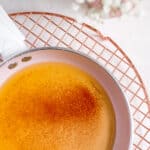Soooo many recipes can be elevated by the complex and nutty flavor of a beautifully browned butter. While it can seem like an intimidating process to learn how to make brown butter, it really couldn't be easier once you understand the few easy steps and what's going on behind the process!

Jump to (scroll for more!):
What is happening when you brown butter...
There are a few different things happening, on a technical level, when you make brown butter. Having an understanding of why you're doing what you do when going through this process will help you master this technique like the pro baker I know you are!
- The melting phase: the butterfat, water, and the milk solids are separating from each other.
- The sizzling, bubbling, and steaming phase: the water in the butter is evaporating. (Butter in the US typically contains 16-18% water by weight). Once all the water is gone, the sizzling stops and you're left with just the butterfat and the milk solids.
- The browning phase: little brown specs start to form on the bottom of your pan; those are the milk solids beginning to cook. Stirring constantly throughout this phase ensures even browning. You can cook the solids to your desired color (the darker the color the more flavorful your butter will be). I prefer a deep amber brown for a nice, nutty flavor.
- The "stop it from cooking" phase: as soon as your desired color is reached you want to stop the cooking. You can do this by either continuing with your recipe, or simply transferring the butter to a heat-safe container. There's nothing worse than seeing your beautifully browned butter turn into black butter. So whatever you do, just don't leave it in the hot pan to keep cooking. Black butter is a sad and bitter fate from which there is no going back, unfortunately.
Check out the video in the instruction card below to see a full tutorial on how to brown butter in action!

What recipes is brown butter good for?
While you have to be careful substituting brown butter for standard butter in some recipes due to the lower water content, it can be a great options for adding extra interest and complexity to all kinds of recipes.
Brown butter chocolate chip cookies are one of my favorites (you could use brown butter in our classic Sea Salt Chocolate Chip Cookies!), and just simple brown butter cookies are delicious too! These BROWN BUTTER RICE KRISPIE even have this delicious ingredient right in their name.
If you're thinking about the savory route of a brown butter sauce...butternut squash ravioli with sage and brown butter sauce is one of my ALL TIME favorite dishes, and one of the best uses of this delicious ingredient I have ever seen.
More on butter...
So what else is there to learn about the magic ingredient that is butter? Let's get back to the basics with a chat about the most important function of butter overall - it's role in bringing all the flavor in Butter 101: Fat is Flavor!
What else is new in the kitchen?
📖 Full Recipe
How to Brown Butter
Ingredients
- 1 stick to 1 pound butter
- heavy-bottomed pan or pot
- heat-proof spatula
- heat-proof storage container (like a mason jar)
Instructions
- Melt it all down: melt your butter in a heavy bottomed pot over medium heat.
- Bubble, sizzle and steam off all the water: stir frequently as the butter sizzles until you see the bubbling and steam stop and the surface begin to get and opaque foam.
- Stir constantly to brown: continue stirring, being sure to regularly scape the entire bottom of the pot until the milk solids (aka the little specs in the bottom of the pot) turn medium to dark amber. The darker the color, the more flavorful the butter (but be sure to stop before a dark brown or black which will be bitter!)
- Remove from heat: immediately transfer your butter to another heat-proof container to cool, or add additional ingredients to stop it from cooking as directed in your recipe as soon as the desired color is reached.
Video
Nutrition

Ready to learn more and put all your new skills to good use?
Check out my newest tutorials and recipes below, and get to baking!
This website contains Amazon affiliate program links. This means that I earn a small commission on qualifying purchases at no additional cost to you. I will never provide a link to nor recommend any product or service that I don’t genuinely love or personally use. Thank you for supporting MINT + MALLOW kitchen and the brands that keep this blog running.




























Comments
No Comments